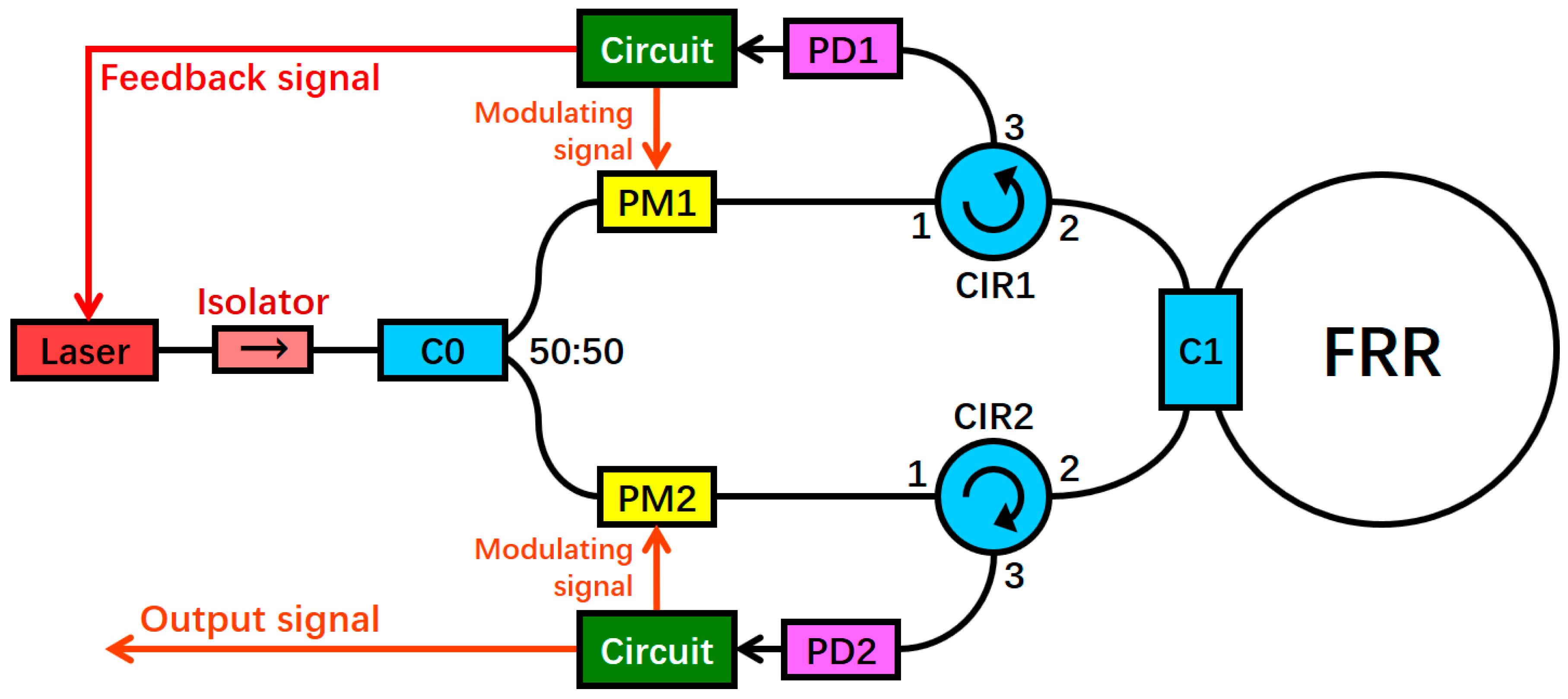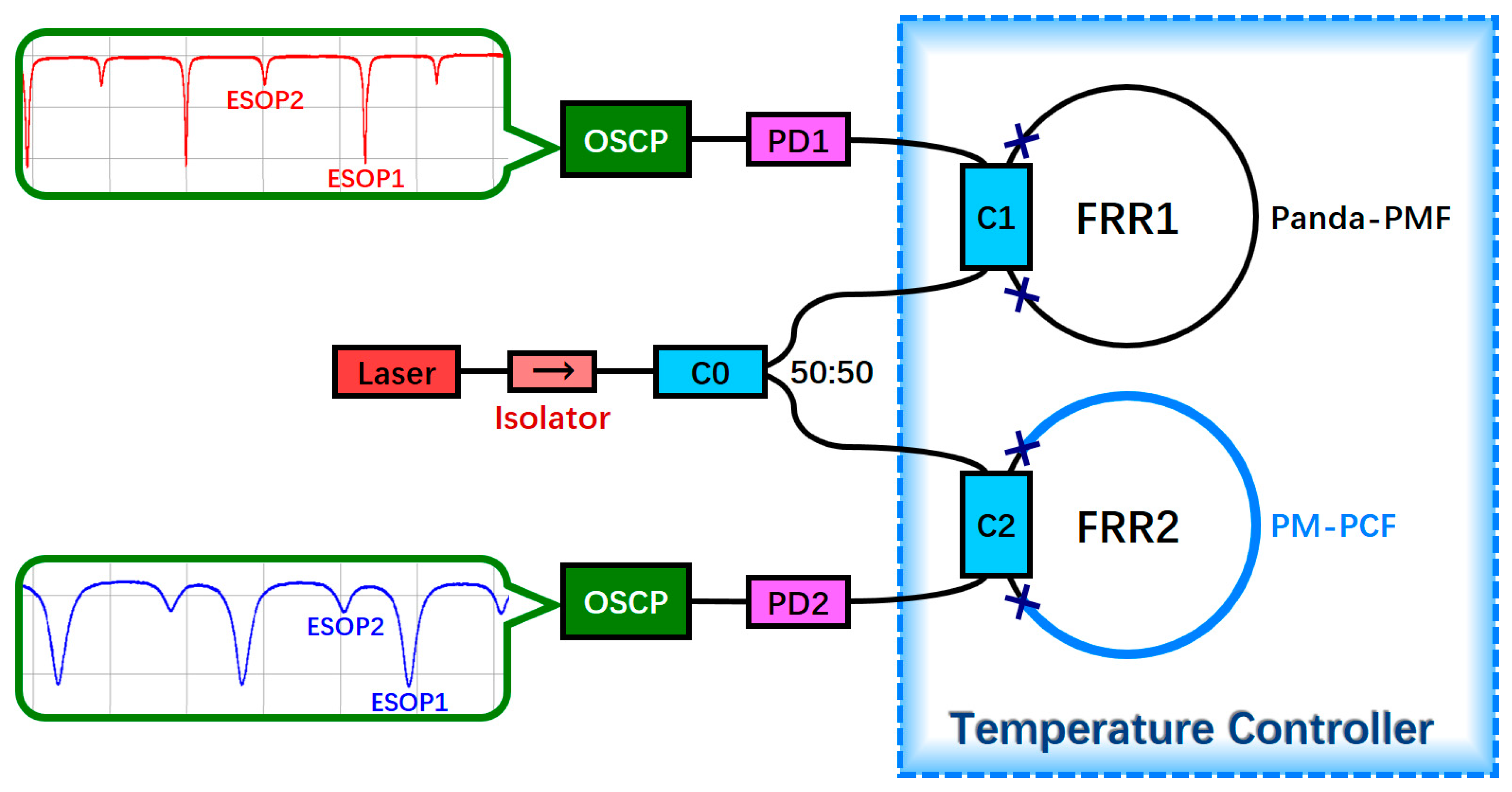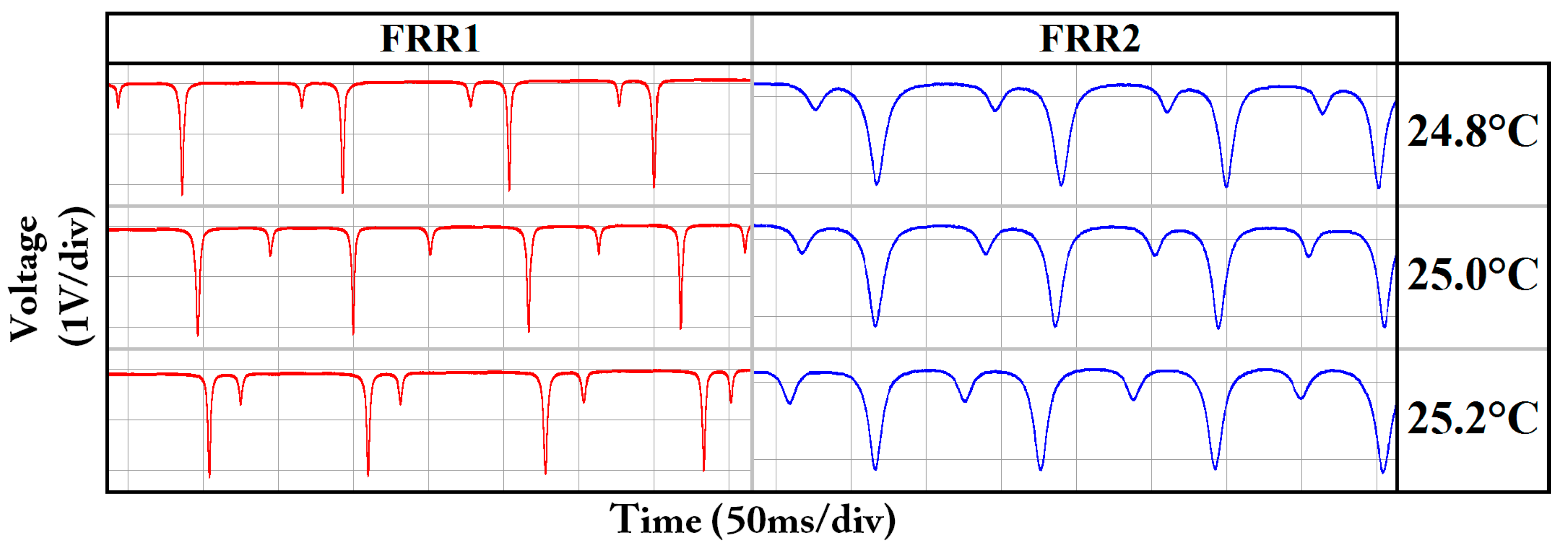Temperature Stability of a Hybrid Polarization-Maintaining Photonic Crystal Fiber Resonator and Its Application in a Resonant Fiber Optic Gyro
Abstract
1. Introduction
2. System Structure of the RFOG
3. Theoretical Analysis and Simulation Results
3.1. Theoretical Analysis of Polarization Fluctuation in FRR
3.1.1. Phase Variation Difference of the Two ESOPS of FRR1
3.1.2. Phase Variation Difference of the Two ESOPS of FRR2
3.1.3. Comparison of Polarization Crosstalk Periods of the Two FRRs
3.2. Multiphysics Finite Element Modeling
4. Experiment
4.1. Experiment System
4.2. Experimental Results and Discussion
5. Conclusions
Author Contributions
Funding
Conflicts of Interest
References
- Wang, L.; Zhang, C.; Gao, S.; Wang, T.; Lin, T.; Li, X. Application of Fast Dynamic Allan Variance for the Characterization of FOGs-Based Measurement While Drilling. Sensors 2016, 16, 2078. [Google Scholar] [CrossRef] [PubMed]
- Meyer, R.E.; Ezekiel, S.; Stowe, D.W.; Tekippe, V.J. Passive fiber-optic ring resonator for rotation sensing. Opt. Lett. 1983, 8, 644–646. [Google Scholar] [CrossRef] [PubMed]
- Li, Z.; He, N.; Sun, X.; Jin, C.; Liu, C.; Wu, X. Analysis of Resonance Asymmetry Phenomenon in Resonant Fiber Optic Gyro. Sensors 2018, 18, 696. [Google Scholar] [CrossRef] [PubMed]
- Qian, K.; Tang, J.; Guo, H.; Liu, W.; Liu, J.; Xue, C.; Zheng, Y.; Zhang, C. Under-Coupling Whispering Gallery Mode Resonator Applied to Resonant Micro-Optic Gyroscope. Sensors 2017, 17, 100. [Google Scholar] [CrossRef] [PubMed]
- Jin, Z.; Yu, X.; Ma, H. Resonator fiber optic gyro employing a semiconductor laser. Appl. Opt. 2012, 51, 2856–2864. [Google Scholar] [CrossRef] [PubMed]
- Ying, D.; Mao, J.; Li, Q.; Jin, Z. A miniaturized compact open-loop RFOG with demodulation signal compensation technique to suppress intensity modulation noise. Opt. Commun. 2016, 359, 364–371. [Google Scholar] [CrossRef]
- Sanders, G.A.; Prentiss, M.G.; Ezekiel, S. Passive ring resonator method for sensitive inertial rotation measurements in geophysics and relativity. Opt. Lett. 1981, 6, 569–571. [Google Scholar] [CrossRef] [PubMed]
- Watsuki, K.; Hotate, K.; Higashiguchi, M. Eigenstate of polarization in a fiber ring resonator and its effect in an optical passive ring-resonator gyro. Appl. Opt. 1986, 25, 2606–2612. [Google Scholar] [CrossRef]
- Yan, Y.; Ma, H.; Jin, Z. Reducing polarization-fluctuation induced drift in resonant fiber optic gyro by using single-polarization fiber. Opt. Exp. 2015, 23, 2002–2009. [Google Scholar] [CrossRef] [PubMed]
- Wang, X.; He, Z.; Hotate, K. Reduction of polarization-fluctuation induced drift in resonator fiber optic gyro by a resonator with twin 90° polarization-axis rotated splices. Opt. Exp. 2010, 18, 1677–1683. [Google Scholar] [CrossRef] [PubMed]
- Sanders, G.A.; Smith, R.B.; Rouse, G.F. Novel polarization-rotating fiber resonator for rotation sensing applications. Proc. SPIE 1989, 1169, 373–381. [Google Scholar]
- Wang, X.; He, Z.; Hotate, K. Analysis of polarization-fluctuation induced bias error in resonator fiber optic gyro with twin 90° polarization-axis rotated splices. Jpn. J. Appl. Phys. 2011, 50, 072501–072504. [Google Scholar] [CrossRef]
- Takiguchi, K.; Hotate, K. Bias of an optical passive ring-resonator gyro caused by the misalignment of the polarization axis in the polarization-maintaining fiber resonator. J. Lightwave Technol. 1992, 10, 514–522. [Google Scholar] [CrossRef]
- Ioannidis, Z.K.; Kadiwar, R.; Giles, I.P. Anisotropic polarization maintaining optical fiber ring resonators. J. Lightwave Technol. 1996, 14, 377–384. [Google Scholar] [CrossRef]
- Strandjord, L.K.; Sanders, G.A. Resonator fiber optic gyro employing a polarization rotating resonator. Proc. SPIE 1992, 1585, 163–172. [Google Scholar]
- Wang, X.; He, Z.; Hotate, K. Automated Suppression of Polarization Fluctuation in Resonator Fiber Optic Gyro With Twin 90° Polarization-Axis Rotated Splices. J. Lightwave Technol. 2013, 31, 366–374. [Google Scholar] [CrossRef]
- Takiguchi, K.; Hotate, K. Evaluation of the output error in an optical passive ring-resonator gyro with a 90 degrees polarization-axis rotation in the polarization-maintaining fiber resonator. IEEE Photon. Technol. Lett. 1991, 3, 88–90. [Google Scholar] [CrossRef]
- Takiguchi, K.; Hotate, K. Reduction of a polarization-fluctuation-induced error in an optical passive ring-resonator gyro by using: a single-polarization optical fiber. J. Lightwave Technol. 1993, 11, 1687–1693. [Google Scholar] [CrossRef]
- Dahlgren, R.P.; Sutherland, R.E. Single-polarization fiber optic resonator for gyro applications. Proc. SPIE 1991, 1585, 128–135. [Google Scholar]
- Ma, H.; Yu, X.; Jin, Z. Reduction of polarization-fluctuation induced drift in resonator fiber optic gyro by a resonator integrating in-line polarizers. Opt. Lett. 2012, 37, 3342–3344. [Google Scholar] [CrossRef] [PubMed]
- Yu, X.; Ma, H.; Jin, Z. Improving thermal stability of a resonator fiber optic gyro employing a polarizing resonator. Opt. Exp. 2013, 21, 358–369. [Google Scholar] [CrossRef] [PubMed]
- Jiao, H.; Feng, L.; Wang, K.; Liu, N.; Yang, Z. Analysis of polarization noise in transmissive single-beam-splitter resonator optic gyro based on hollow-core photonic-crystal fiber. Opt. Exp. 2017, 25, 27806–27817. [Google Scholar] [CrossRef] [PubMed]
- Ma, H.; Zhang, J.; Wang, L.; Jin, Z. Development and Evaluation of Optical Passive Resonant Gyroscopes. J. Lightwave Technol. 2017, 35, 3546–3554. [Google Scholar] [CrossRef]
- Bobbili, P.R.; Nayak, J.; Pinnoji, P.D.; Reddy, D.V.R.K. Parameter optimization analysis to minimize the polarization error in a localized thermal tunable fiber ring resonator gyro. Appl. Opt. 2016, 55, 1996–2001. [Google Scholar] [CrossRef] [PubMed]
- Ma, H.; Chen, Z.; Yang, Z.; Yu, X.; Jin, Z. Polarization-induced noise in resonator fiber optic gyro. Appl. Opt. 2012, 51, 6708. [Google Scholar] [CrossRef] [PubMed]
- Ma, H.; Chen, Z.; Jin, Z. Single-Polarization Coupler Based on Air-Core Photonic Bandgap Fibers and Implications for Resonant Fiber Optic Gyro. J. Lightwave Technol. 2014, 32, 46–54. [Google Scholar] [CrossRef]
- Ma, H.; Yan, Y.; Chen, Y.; Jin, Z. Improving Long-Term Stability of a Resonant Micro-Optic Gyro by Reducing Polarization Fluctuation. IEEE Photonics J. 2012, 4, 2372–2381. [Google Scholar]
- Song, N.; Ma, P.; Jin, J.; Song, J. Reduced phase error of a fiber optic gyroscope using a polarization maintaining photonic crystal fiber. Opt. Fiber Technol. 2012, 18, 186–189. [Google Scholar] [CrossRef]
- Song, N.; Cai, W.; Song, J.; Jin, J.; Wu, C. Structure optimization of small-diameter polarization-maintaining photonic crystal fiber for mini coil of spaceborne miniature fiber-optic gyroscope. Appl. Opt. 2015, 54, 9831. [Google Scholar] [CrossRef] [PubMed]
- Zhang, C.; Zhang, Z.; Xu, X.; Cai, W. Thermally Optimized Polarization-Maintaining Photonic Crystal Fiber and Its FOG Application. Sensors 2018, 18, 567. [Google Scholar] [CrossRef] [PubMed]
- Sun, Z.; Wang, S.; Li, J.; Zhang, Y.; Chen, D. Analysis of bias thermal stability of interferometer fiber-optic gyroscope using a solid-core polarization-maintaining photonic crystal fiber. Opt. Rev. 2016, 23, 968–975. [Google Scholar]
- Shi, C.; Hotate, K. Bias of a resonator fiber optic gyro composed of a polarization-maintaining fiber ring resonator with the photoinduced birefingent grating. J. Lightwave Technol. 1995, 13, 1853–1857. [Google Scholar]
- Zhang, R.; Lu, H.; Liu, Y.; Mao, X.; Wei, H.; Li, J.; Guo, J. Polarization-maintaining photonic crystal fiber based quarter waveplate for temperature stability improvement of fiber optic current sensor. J. Mod. Opt. 2013, 60, 963–969. [Google Scholar] [CrossRef]
- Esposito, F.; Ranjan, R.; Campopiano, S.; Iadicicco, A. Arc-Induced Long Period Gratings from Standard to Polarization-Maintaining and Photonic Crystal Fibers. Sensors 2018, 18, 918. [Google Scholar] [CrossRef] [PubMed]
- Kim, H.K.; Digonnet, M.J.F.; Kino, G.S. Air-Core Photonic-Bandgap Fiber-Optic Gyroscope. J. Lightwave Technol. 2006, 24, 3169–3174. [Google Scholar]
- Terrel, M.A.; Digonnet, M.J.F.; Fan, S. Resonant Fiber Optic Gyroscope Using an Air-Core Fiber. J. Lightwave Technol. 2012, 30, 931–937. [Google Scholar] [CrossRef]
- Ma, P.; Song, N.; Jin, J.; Song, J.; Xu, X. Birefringence sensitivity to temperature of polarization maintaining photonic crystal fibers. Opt. Laser Technol. 2012, 44, 1829–1833. [Google Scholar] [CrossRef]
- Dangui, V.; Kim, H.K.; Digonnet, M.J.F.; Kino, G.S. Phase sensitivity to temperature of the fundamental mode in air-guiding photonic-bandgap fibers. Opt. Exp. 2005, 18, 6669–6684. [Google Scholar] [CrossRef]
- Ju, J.; Wang, Z.; Jin, W.; Demokan, M.S. Temperature sensitivity of a two-mode photonic crystal fiber interferometric sensor. IEEE Photonics Technol. Lett. 2006, 20, 2168–2170. [Google Scholar]
- Blin, S.; Kim, H.K.; Digonnet, M.J.F.; Kino, G.S. Reduced thermal sensitivity of a fiber-optic gyro scope using an air-core photonic-bandgap fiber. J. Lightwave Technol. 2007, 3, 861–865. [Google Scholar] [CrossRef]
- Zhao, H.; Chen, M.; Li, G. Temperature dependence of birefringence in polarization-maintaining photonic crystal fibres. Chin. Phys. B 2012, 21, 068404. [Google Scholar] [CrossRef]
- Ritari, T.; Ludvigsen, H.; Wegmuller, M.; Legré, M.; Gisin, N.; Folkenberg, J.; Nielsen, M. Experimental study of polarization properties of highly birefringent photonic crystal fibers. Opt. Exp. 2004, 12, 5931–5939. [Google Scholar] [CrossRef]
- Song, J.; Cai, W.; Li, S.; Sun, K. Phase sensitivity to temperature of the guiding mode in polarization-maintaining photonic crystal fiber. Appl. Opt. 2015, 54, 7330. [Google Scholar] [CrossRef] [PubMed]
- Sun, Z.; Song, N.; Jin, J.; Song, J.; Ma, P. Low loss fusion splicing polarization-maintaining photonic crystal fiber and conventional polarization-maintaining fiber. Opt. Fiber Technol. 2012, 18, 452–456. [Google Scholar]








| Panda-PMF | PM-PCF |
|---|---|
| Core diameter = 6 μm SAPs diameter = 36 μm Distance between SAPs and core = 28 μm | Small hole diameter = 4 μm Large hole diameter = 7.2 μm Minimum spacing of small hole Λ = 6.7 μm Deviation of small hole Δ = 0.57 Number of layers of small hole = 7 |
| Acrylate diameter = 250 μm Cladding diameter = 125 μm | |
| Material | Acrylate | SiO2 | SiO2 + GeO2 | SiO2 + B2O3 |
|---|---|---|---|---|
| Thermal expansion coefficient α (10−6/K) | 80 | 0.55 | 0.62 | 2.42 |
| Poisson’s ratio ν | 0.38 | 0.17 | 0.17 | 0.20 |
| Young’s modulus E (GPa) | 0.6 | 72.4 | 72.4 | 49.2 |
| Thermal Coefficient | Theoretical Simulation Results | Experimental Results |
|---|---|---|
| dΔneff/dT | −4.62 × 10−7/°C | −4.8091 × 10−7/°C |
| dΔn’eff/dT | −0.41 × 10−7/°C | −0.3712 × 10−7/°C |
| (dΔneff/dT)/(dΔn’eff/dT) | 11.268 | 12.955 |
© 2018 by the authors. Licensee MDPI, Basel, Switzerland. This article is an open access article distributed under the terms and conditions of the Creative Commons Attribution (CC BY) license (http://creativecommons.org/licenses/by/4.0/).
Share and Cite
He, N.; Li, Z.; Zhang, G.; Liu, A.; Zhou, D.; Chen, P.; Liu, C.; Wu, X. Temperature Stability of a Hybrid Polarization-Maintaining Photonic Crystal Fiber Resonator and Its Application in a Resonant Fiber Optic Gyro. Sensors 2018, 18, 2506. https://doi.org/10.3390/s18082506
He N, Li Z, Zhang G, Liu A, Zhou D, Chen P, Liu C, Wu X. Temperature Stability of a Hybrid Polarization-Maintaining Photonic Crystal Fiber Resonator and Its Application in a Resonant Fiber Optic Gyro. Sensors. 2018; 18(8):2506. https://doi.org/10.3390/s18082506
Chicago/Turabian StyleHe, Nie, Zhuoyan Li, Gongshen Zhang, An’an Liu, Ding Zhou, Peng Chen, Chengxiang Liu, and Xu Wu. 2018. "Temperature Stability of a Hybrid Polarization-Maintaining Photonic Crystal Fiber Resonator and Its Application in a Resonant Fiber Optic Gyro" Sensors 18, no. 8: 2506. https://doi.org/10.3390/s18082506
APA StyleHe, N., Li, Z., Zhang, G., Liu, A., Zhou, D., Chen, P., Liu, C., & Wu, X. (2018). Temperature Stability of a Hybrid Polarization-Maintaining Photonic Crystal Fiber Resonator and Its Application in a Resonant Fiber Optic Gyro. Sensors, 18(8), 2506. https://doi.org/10.3390/s18082506





